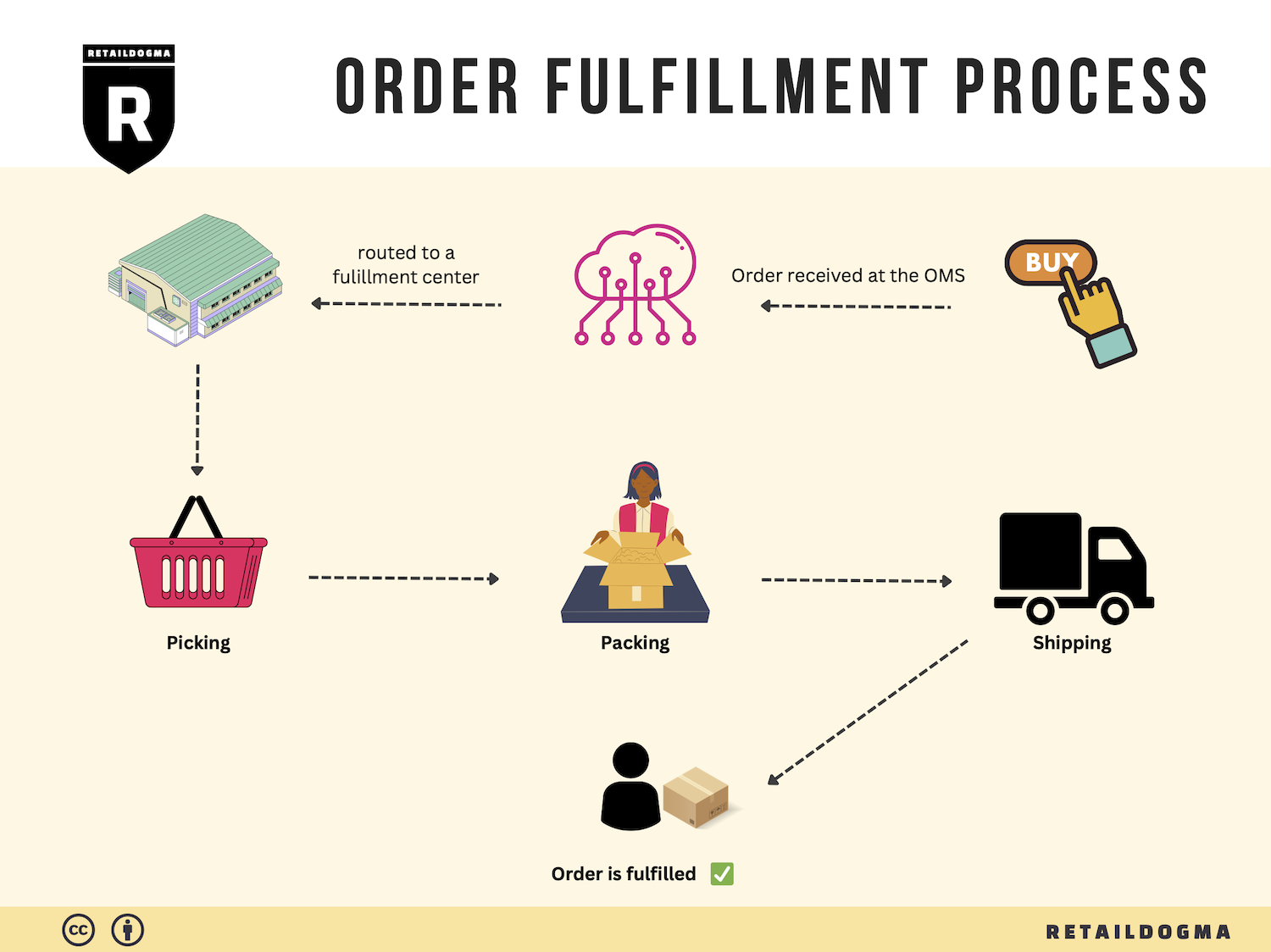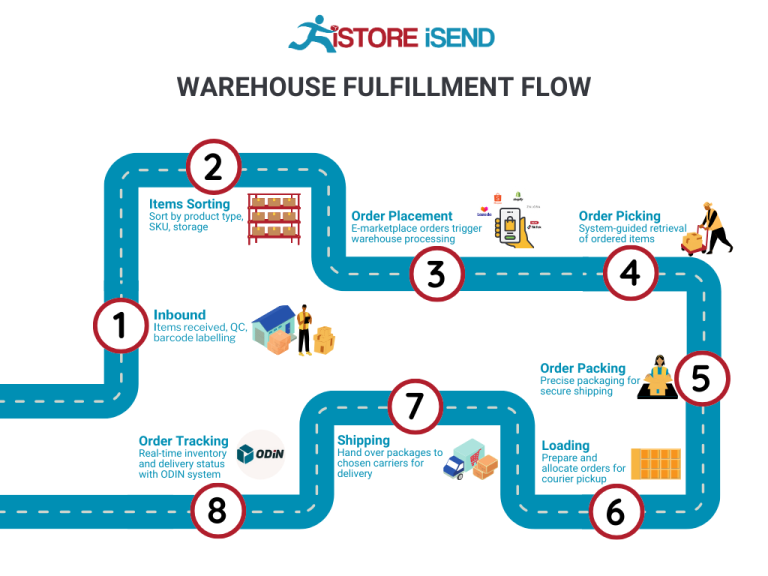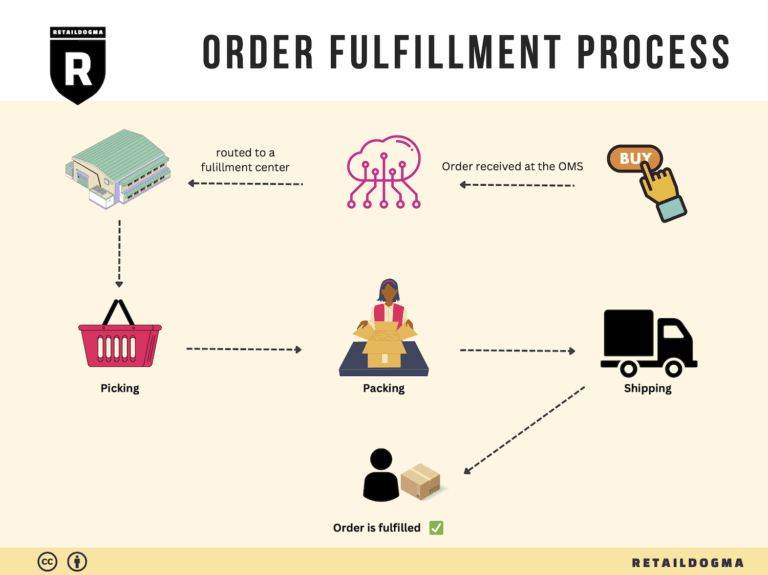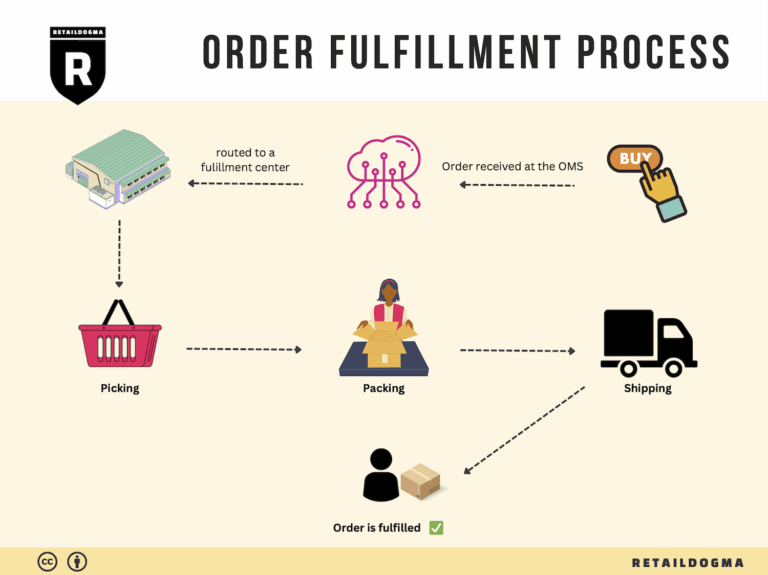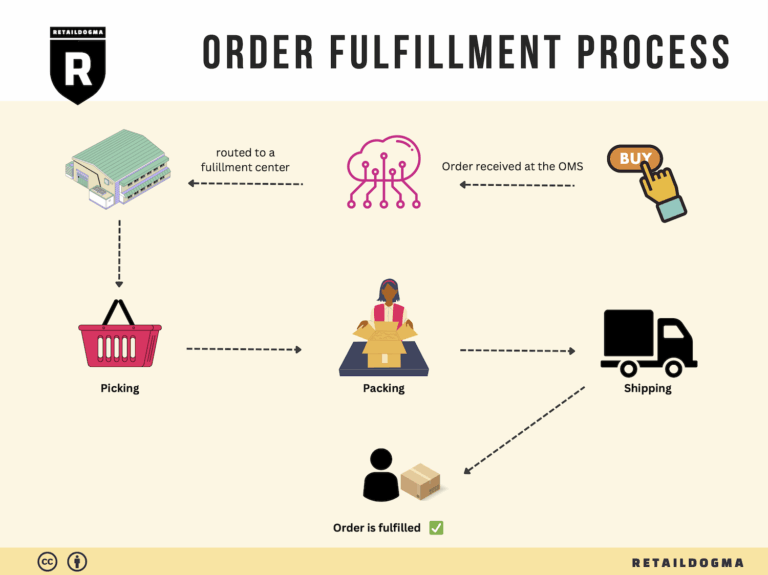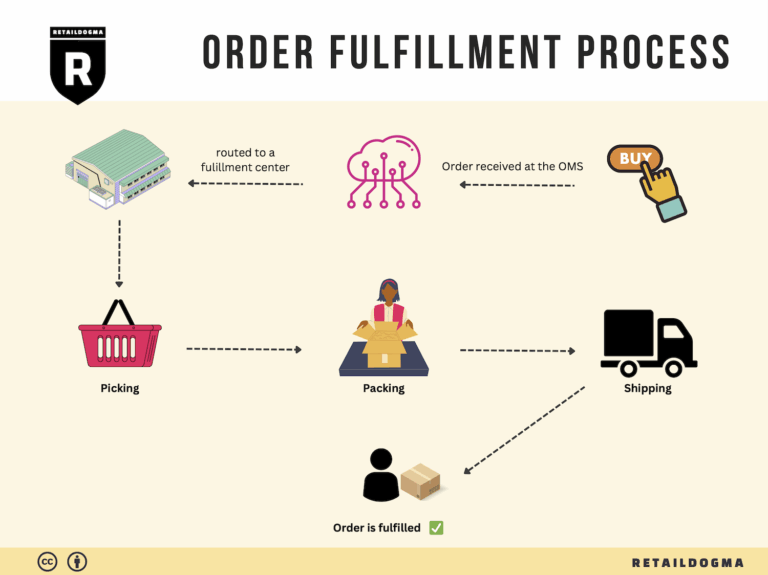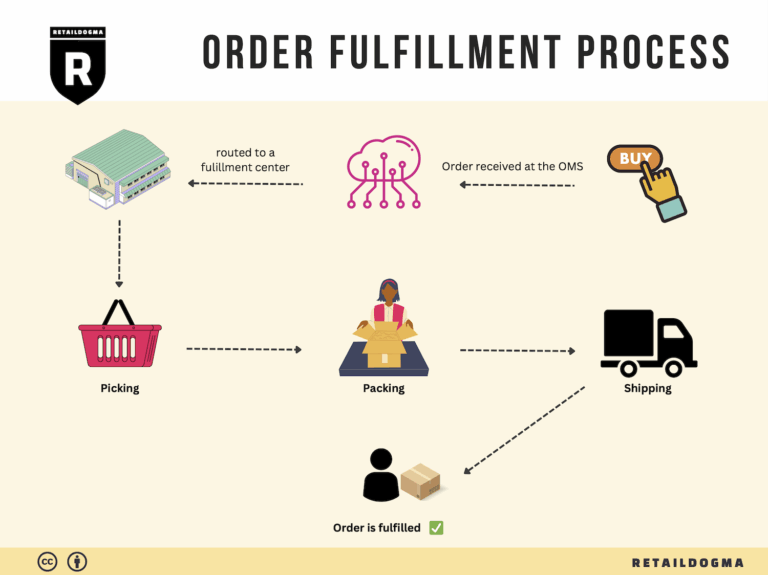What Is A Fulfillment Center? A Complete Guide (2025)
What is E-commerce Fulfillment? An Introduction for Growing Businesses
Understanding E-commerce Fulfillment
As an e-commerce business owner, you may find yourself grappling with one of the most common challenges of growth: the overwhelming process of packing and shipping orders. Managing logistics can quickly transform from a minor task into a daunting burden, especially as your sales volume increases. This is where understanding e-commerce fulfillment becomes essential.
E-commerce fulfillment is simply the process of getting a product from your inventory to your customer’s doorstep. It involves a series of steps including inventory management, order processing, picking and packing, shipping, and handling returns. As your business scales, these tasks can become increasingly complex and time-consuming, pulling your focus away from growing your business.
In this guide, we will explore various fulfillment models that can simplify your logistics. You’ll learn about third-party logistics (3PL) providers, who can handle warehousing and shipping on your behalf, and Fulfillment by Amazon (FBA), which allows you to leverage Amazon’s extensive logistics network to reach customers more efficiently. Each model offers unique advantages and challenges, and understanding them will help you make informed decisions.
We will also delve into the core services that fulfillment centers typically provide, such as inventory storage, order processing, packaging, shipping, and returns management. Knowing what services to expect will enable you to evaluate potential partners more effectively.
Choosing the right fulfillment partner is critical for your business’s success. We will guide you through the key factors to consider, including location, scalability, technology integration, and customer service. A strong partnership can enhance your operational efficiency and improve customer satisfaction.
Lastly, we will address pricing structures and what costs you should anticipate when engaging a fulfillment service. Understanding these financial aspects will allow you to budget effectively and avoid any unexpected expenses that could impact your margins.
The ultimate goal of this guide is to empower you as a business owner to make smart, strategic decisions about your logistics operations. By demystifying the fulfillment process and providing practical insights, we aim to equip you with the knowledge needed to streamline your operations, enhance your customer experience, and drive your business growth. Whether you are just starting to explore fulfillment options or looking to optimize your current processes, this guide will serve as a valuable resource on your journey toward efficient e-commerce fulfillment.
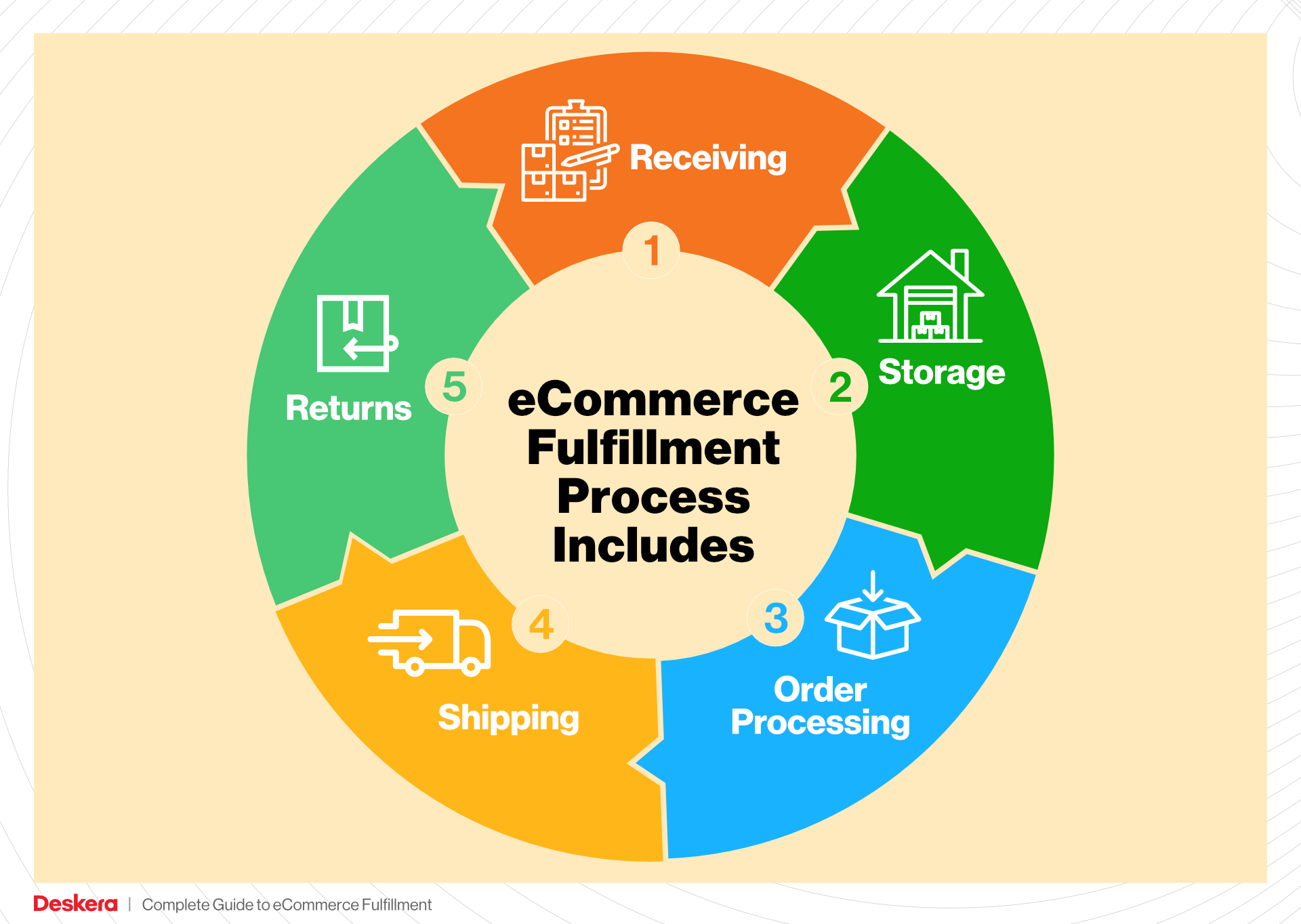
What You’ll Learn In This Guide
- What is E-commerce Fulfillment? An Introduction for Growing Businesses
- The Order Fulfillment Process: From ‘Buy’ Button to Customer’s Door
- Comparing Fulfillment Models: In-House vs. 3PL vs. Dropshipping
- A Deep Dive into Amazon FBA: Pros, Cons, and Who It’s For
- Core Services Offered by Fulfillment Centers
- How to Choose a Fulfillment Partner: A 6-Point Checklist
- Understanding Fulfillment Pricing: A Breakdown of Common Fees
- Frequently Asked Questions (FAQs) about Fulfillment
- Conclusion: Is Outsourcing Fulfillment the Right Move for Your Business?
- Important Disclaimer
The Order Fulfillment Process: From ‘Buy’ Button to Customer’s Door
1. Receiving Inventory
The first step in the order fulfillment process is the receipt of inventory at the fulfillment center, such as Amazon’s PSC2 in Pasco, WA. During this stage, incoming shipments are unloaded from trucks at designated docking stations. Each package is scanned using optical recognition technology, which automatically registers the items into the warehouse management system (WMS). This process ensures that inventory levels are accurately updated in real-time.
Importance: Efficient inventory receiving is critical as it sets the foundation for the entire order fulfillment cycle. If inventory is not received correctly, it can lead to stock discrepancies, which can cause delays in order processing and negatively impact customer satisfaction.
Key Term: SKU (Stock Keeping Unit) – This unique identifier is essential for tracking inventory levels and managing stock across various channels.
2. Warehouse Storage
Once the inventory has been received and logged into the system, it is stored in designated areas within the fulfillment center. Storage strategies can vary based on item size, type, and turnover rates. For example, fast-moving items might be placed in easily accessible locations, while slower-moving products are stored in less accessible areas.
Importance: Effective warehouse storage maximizes space utilization and facilitates quicker retrieval of items during the order picking phase. Proper organization and categorization of products are crucial for maintaining operational efficiency.
Key Term: ABC Analysis – This inventory categorization technique helps prioritize inventory management efforts by classifying items based on their importance and sales volume.

3. Order Picking
When a customer places an order, the next step is order picking. This involves retrieving the items from storage based on a generated pick list, which outlines the products and their locations within the warehouse. Workers use handheld devices or mobile scanners to locate and pick the correct items efficiently.
Importance: The picking process directly impacts order accuracy and fulfillment speed. Errors during picking can lead to incorrect shipments, resulting in returns and dissatisfied customers. Streamlining this process is vital for maintaining a competitive edge in e-commerce.
Key Term: Pick List – A document that outlines which items to retrieve for an order, including their storage locations. It is essential for guiding warehouse staff during the picking process.
4. Order Packing
After the items have been picked, they move to the packing station. Here, workers verify the items against the order details to ensure accuracy before packing them securely for shipment. This step often includes weighing packages, labeling them with shipping information, and preparing them for transport.
Importance: Packing is not just about securing the items; it also involves branding and customer experience. Well-packed orders reduce the risk of damage during transit and enhance the overall presentation of the product when it reaches the customer.
Key Term: Packing Slip – This document accompanies the shipment and provides a list of the items included in the package, serving as both a receipt for the customer and a verification tool for the fulfillment center.
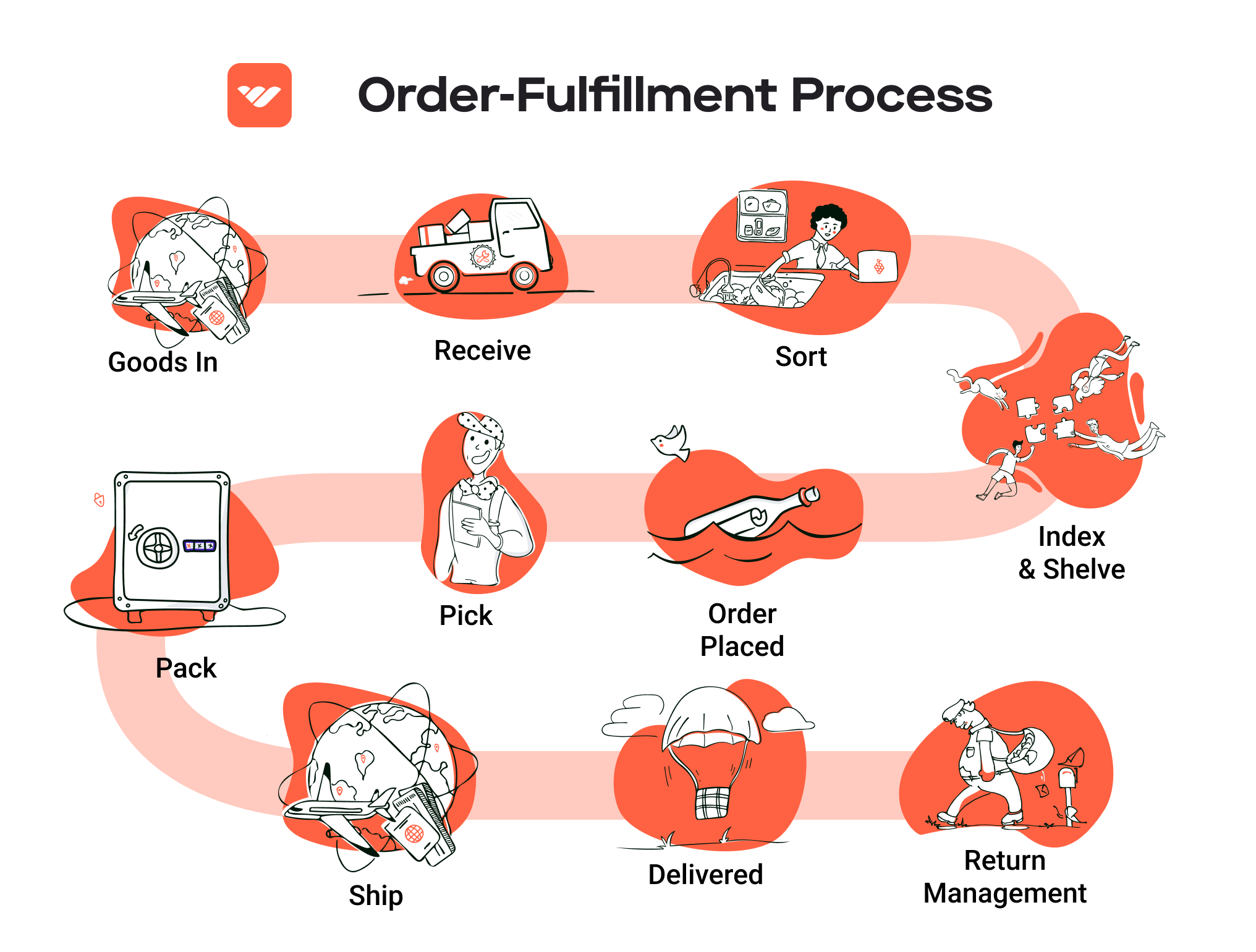
5. Shipping & Delivery
The final step in the order fulfillment process is shipping and delivery. Once the packages are packed, they are sorted based on their destination and loaded onto delivery vehicles. In Amazon’s network, this can involve multiple transit points, including regional distribution centers and last-mile delivery stations.
Importance: Timely shipping and delivery are critical for customer satisfaction. In an era where fast delivery is expected, optimizing shipping routes and methods can significantly enhance a business’s reputation and customer loyalty.
Key Term: Last-Mile Delivery – This term refers to the final step of the shipping process, where the package is delivered from a transportation hub to the final destination, often the customer’s doorstep. Efficient last-mile delivery is crucial for meeting customer expectations for speed and reliability.
By understanding and optimizing each of these five steps, e-commerce businesses can significantly enhance their order fulfillment process, ultimately leading to improved customer satisfaction and business scalability.
Comparing Fulfillment Models: In-House vs. 3PL vs. Dropshipping
Fulfillment Model Comparison
| Model | Who Handles Inventory | Best For (Business Stage) | Key Advantage | Key Disadvantage |
|---|---|---|---|---|
| In-House Fulfillment | The business itself | Startups to Established | Full control over inventory and processes | High overhead costs and complexity |
| Third-Party Logistics (3PL) | External logistics provider | Growing to Established | Scalability and reduced operational burden | Less control over inventory and processes |
| Dropshipping | Supplier or manufacturer | Startups and Small Businesses | Low startup costs and inventory risk | Lower profit margins and reliance on suppliers |
In-House Fulfillment
In-house fulfillment is a model where e-commerce businesses manage their own inventory and shipping processes. This typically involves renting or owning warehouse space, hiring staff, and managing logistics internally. This model is most suitable for businesses that are either just starting out or have reached a stable growth phase and wish to maintain control over their entire supply chain. The key advantage of in-house fulfillment is that it allows for complete oversight of inventory management and order fulfillment processes. Businesses can customize their operations to meet specific customer needs, ensuring a personalized service that can enhance customer satisfaction and brand loyalty. However, the primary disadvantage is the high overhead costs associated with maintaining warehouse space, staffing, and logistics infrastructure. As businesses scale, these complexities can lead to inefficiencies and increased operational costs, making it essential to evaluate whether this model remains viable as sales grow.
Third-Party Logistics (3PL)
Third-party logistics (3PL) involves outsourcing logistics and fulfillment services to specialized providers. These companies handle warehousing, inventory management, and shipping, allowing businesses to focus on core activities such as marketing and sales. 3PL is ideal for growing businesses that require flexibility and scalability without the burden of managing physical logistics. The key advantage of using a 3PL provider is that it significantly reduces operational burdens and allows businesses to scale quickly without the need for large capital investments in infrastructure. As order volumes increase, businesses can easily adjust their logistics needs without the complexities of managing additional warehouse space or staff. However, a significant downside is the potential loss of control over inventory and fulfillment processes. Businesses may find it challenging to ensure consistent quality and service levels, which can affect customer satisfaction if the 3PL provider does not meet expectations.
Dropshipping
Dropshipping is a fulfillment model where businesses sell products without holding any inventory. Instead, when a customer places an order, the retailer purchases the item from a third-party supplier, who then ships it directly to the customer. This model is particularly appealing for startups and small businesses, as it requires minimal upfront investment and eliminates the risks associated with unsold inventory. The primary advantage of dropshipping is its low barrier to entry, allowing entrepreneurs to start an e-commerce business with little capital. Additionally, it provides flexibility in product offerings, as businesses can easily test new products without significant financial commitments. However, dropshipping also comes with notable disadvantages. Profit margins can be lower due to reliance on suppliers, and businesses may face challenges with shipping times and product quality, which can impact customer satisfaction. Furthermore, the dependence on third-party suppliers can lead to issues with inventory availability and fulfillment consistency, making it crucial for dropshippers to establish strong relationships with reliable suppliers.
Conclusion
Choosing the right fulfillment model is a critical decision for e-commerce businesses looking to scale their operations. Each model presents unique advantages and disadvantages that must be carefully weighed against the company’s current stage, growth ambitions, and operational capabilities. In-house fulfillment offers complete control but at a higher cost and complexity, while 3PL provides scalability and reduced overhead but may sacrifice some control. Dropshipping lowers financial risks but can lead to challenges with supplier reliability and profit margins. Understanding these dynamics will enable business owners and operations managers to make informed decisions that align with their growth strategies and customer service goals.
A Deep Dive into Amazon FBA: Pros, Cons, and Who It’s For
Understanding Fulfillment by Amazon (FBA)
Fulfillment by Amazon (FBA) is a service that allows e-commerce sellers to leverage Amazon’s vast logistics network for storing, packing, and shipping their products. By utilizing FBA, sellers can store their inventory in Amazon’s fulfillment centers, and when a customer places an order, Amazon takes care of the entire fulfillment process, including shipping and customer service. This service not only streamlines operations for sellers but also enhances customer experience, as Amazon is renowned for its efficient and reliable service.
How FBA Works
-
Setting Up an Account: Sellers first create an Amazon seller account and enroll in the FBA program.
-
Product Listing: Once enrolled, sellers list their products on Amazon and specify that they will use FBA for fulfillment.
-
Shipping Inventory: Sellers then prepare their products for shipment to Amazon’s fulfillment centers. This includes packaging and labeling the items according to Amazon’s guidelines.
-
Storage: Upon arrival at the fulfillment center, Amazon takes over. The products are stored in Amazon’s warehouses until an order is placed.
-
Order Fulfillment: When a customer orders a product, Amazon handles the picking, packing, and shipping of the item. They also manage returns and customer service inquiries.
-
Tracking and Reports: Sellers have access to real-time tracking of their inventory and sales performance through the Amazon Seller Central dashboard.
Pros of Using FBA
1. Prime Eligibility
Products fulfilled by Amazon are eligible for Amazon Prime, which can significantly enhance visibility and attract more customers. Prime members often prefer Prime-eligible products due to fast and free shipping options, leading to increased sales potential.
2. Customer Trust
Amazon’s brand is synonymous with reliability and customer satisfaction. By using FBA, sellers benefit from Amazon’s established reputation, which can lead to higher conversion rates as customers are more likely to purchase from a trusted source.
3. Multi-Channel Fulfillment
FBA is not limited to Amazon sales alone. Sellers can use FBA to fulfill orders from other sales channels, including their own websites and other e-commerce platforms. This allows for a streamlined logistics process across multiple channels, enhancing operational efficiency.
4. Time Savings
Outsourcing storage, packing, and shipping to Amazon saves sellers significant time, allowing them to focus on other critical aspects of their business such as marketing and product development.
5. Scalability
FBA offers flexibility for businesses looking to scale. Sellers can easily increase their inventory without worrying about storage space or fulfillment logistics, as Amazon’s network can accommodate growing business needs.
Cons of Using FBA
1. High Fees
FBA comes with various fees, including storage fees and fulfillment fees. These costs can add up, especially for sellers with lower-margin products or those with excess inventory. It’s crucial for sellers to calculate their costs accurately to ensure profitability.
2. Strict Inventory Rules
Amazon has specific policies regarding inventory management, including limits on how long products can be stored in their warehouses. Sellers must be diligent in managing their inventory to avoid long-term storage fees and potential penalties.
3. Commingling Risks
FBA allows for commingling of inventory, meaning that sellers’ products may be stored alongside those of other sellers. This can lead to potential issues, such as receiving returns that belong to another seller, which complicates inventory management and can affect brand reputation.
4. Loss of Control
Using FBA means relinquishing some control over the fulfillment process. Sellers must adhere to Amazon’s policies and procedures, which may not always align with their own operational preferences.
5. Limited Branding Opportunities
Products fulfilled by Amazon often lack personalized branding options, as items are shipped in Amazon packaging. This can dilute brand identity and reduce the opportunity for brand loyalty among customers.
Who is FBA Best For?
FBA is particularly well-suited for:
-
Small to Medium-Sized Businesses: Businesses that may not have the resources to manage their own fulfillment can benefit significantly from FBA’s scalability and efficiency.
-
E-commerce Entrepreneurs: New sellers looking to establish a presence on Amazon and tap into its vast customer base can leverage FBA to enhance visibility and credibility.
-
High-Volume Sellers: Businesses that sell products with a high turnover rate will find FBA advantageous due to its ability to handle large volumes of orders efficiently.
-
Sellers with Seasonal Products: FBA can help sellers manage inventory fluctuations during peak seasons without the need for a large investment in logistics infrastructure.
In conclusion, Fulfillment by Amazon offers a compelling solution for many e-commerce businesses looking to streamline their operations and enhance customer satisfaction. However, it is essential to weigh the pros and cons carefully and consider how FBA aligns with specific business needs and goals. By doing so, sellers can make informed decisions that support their growth and operational efficiency in the competitive e-commerce landscape.
Core Services Offered by Fulfillment Centers
Inventory Management & Warehousing
Inventory management and warehousing form the backbone of any successful e-commerce operation. Fulfillment centers provide a secure, organized space to store goods, enabling businesses to manage their inventory efficiently. This service includes real-time tracking of stock levels, automated reordering processes, and integration with e-commerce platforms to ensure that product availability is always up to date.
Benefits:
1. Optimized Space Utilization: Fulfillment centers are designed to maximize storage space, allowing businesses to store large quantities of products without the overhead costs associated with owning and maintaining a warehouse.
2. Scalability: As your business grows, fulfillment centers can easily accommodate increased inventory, allowing for seamless scalability without the need for significant capital investment in physical space.
3. Reduced Risk of Stockouts: With advanced inventory management systems, businesses can minimize the risk of stockouts or overstock situations, ensuring that they can meet customer demand while keeping carrying costs low.
Pick and Pack Services
Pick and pack services are critical for e-commerce businesses that require quick and accurate order fulfillment. This process involves selecting items from the warehouse, packing them securely, and preparing them for shipment. Fulfillment centers employ sophisticated technology and trained staff to ensure that orders are picked accurately and packed efficiently.
Benefits:
1. Speed and Efficiency: Fulfillment centers utilize advanced picking technologies, such as automated picking systems and optimized picking paths, which drastically reduce the time taken to fulfill orders. This leads to faster shipping times and improved customer satisfaction.
2. Accuracy: By implementing robust quality control measures, fulfillment centers ensure that orders are picked and packed correctly, minimizing the likelihood of returns due to incorrect shipments.
3. Cost Savings: Outsourcing pick and pack services can reduce labor costs associated with hiring and training in-house staff, as fulfillment centers typically have specialized teams dedicated to this function.
Kitting and Assembly
Kitting and assembly services involve combining various products into a single package or creating custom product bundles before shipping. This service is particularly beneficial for businesses that sell items that are often purchased together or require assembly before use.
Benefits:
1. Enhanced Customer Experience: By offering bundled products or pre-assembled items, businesses can provide customers with a more convenient shopping experience, potentially increasing average order values and customer satisfaction.
2. Streamlined Operations: Kitting and assembly services help simplify the supply chain by reducing the number of individual SKUs that need to be managed, allowing businesses to focus on core operations without getting bogged down in logistics.
3. Flexibility: Fulfillment centers can adapt to changing market demands by quickly assembling new kits or bundles, providing businesses with the agility needed to respond to customer preferences and trends.
Returns Management (Reverse Logistics)
Returns management, or reverse logistics, is a vital service offered by fulfillment centers, especially for e-commerce businesses where return rates can be significant. This service includes handling returned merchandise, processing refunds or exchanges, and managing restocking or disposal of returned items.
Benefits:
1. Improved Customer Retention: Efficient returns management processes can enhance customer trust and satisfaction. A hassle-free return experience can lead to repeat purchases and positive word-of-mouth referrals.
2. Cost Efficiency: Fulfillment centers can optimize the returns process, minimizing costs associated with handling returns and ensuring that returned items are quickly processed and reintroduced into inventory, thereby reducing lost revenue.
3. Data Insights: By analyzing returns data, businesses can gain valuable insights into customer behavior, product performance, and potential quality issues, allowing for informed decision-making and continuous improvement in product offerings.
Conclusion
In summary, leveraging the core services offered by fulfillment centers can significantly enhance an e-commerce business’s operational efficiency and customer satisfaction. From effective inventory management and streamlined pick and pack processes to flexible kitting and robust returns management, fulfillment centers provide the essential support that allows businesses to focus on growth and scalability in an increasingly competitive marketplace. By partnering with a fulfillment center, e-commerce businesses can optimize their logistics, reduce overhead costs, and ultimately drive sales while providing an exceptional customer experience.
How to Choose a Fulfillment Partner: A 6-Point Checklist
Location & Warehouse Network
Why It’s Important:
The geographical location of your fulfillment partner’s warehouses directly affects shipping times, costs, and customer satisfaction. A strategically located fulfillment center can significantly reduce transit times and shipping costs, enhancing your overall service level.
Questions to Ask:
– Where are your warehouses located, and how does that align with my target markets?
– What is your average shipping time to major regions?
– Do you have multiple locations that enable regional fulfillment?
– How do you handle shipping during peak seasons or unexpected spikes in demand?
Technology & Integrations
Why It’s Important:
A modern fulfillment partner should utilize advanced technology to streamline operations and provide real-time visibility into inventory and order status. The ability to integrate with your e-commerce platform (like Amazon, Shopify, etc.) is crucial for operational efficiency.
Questions to Ask:
– What technology do you use for inventory management and order processing?
– Can your system integrate with my existing e-commerce platform?
– How do you ensure data accuracy and security in your operations?
– Do you offer real-time tracking for both inventory and shipments?
Specializations (e.g., cold storage, oversized items)
Why It’s Important:
Different products require different handling and storage conditions. If your business involves specialized items such as perishables or oversized goods, it’s essential to partner with a fulfillment provider experienced in those areas.
Questions to Ask:
– What types of products do you specialize in handling?
– Do you have facilities for cold storage or climate-controlled environments?
– How do you manage oversized or heavy items in your fulfillment process?
– Can you accommodate specific packaging or handling requirements for my products?
Scalability & Capacity
Why It’s Important:
As your business grows, your fulfillment needs will likely change. A capable partner should be able to scale with you, providing the necessary capacity and flexibility without compromising service quality.
Questions to Ask:
– How do you handle fluctuations in order volume, especially during peak seasons?
– What is your current capacity, and how quickly can you scale up if needed?
– Are there limitations on the types or volumes of products you can handle?
– How do you support businesses during rapid growth or expansion into new markets?
Pricing and Contracts
Why It’s Important:
Understanding the pricing structure and contract terms is vital to ensure your partnership remains profitable. Look for transparency in pricing and flexibility in contracts to avoid hidden fees or long-term commitments that may not serve your evolving needs.
Questions to Ask:
– What is your pricing model (e.g., per order, per item, monthly fees)?
– Are there any additional fees I should be aware of (e.g., storage fees, seasonal surcharges)?
– What are the contract terms, and is there flexibility for renegotiation?
– Can you provide examples of how your pricing compares to other fulfillment partners?
Customer Support & Reviews
Why It’s Important:
Exceptional customer support is crucial for resolving issues quickly and maintaining operational efficiency. Additionally, researching reviews and testimonials can provide insight into the partner’s reliability and service quality.
Questions to Ask:
– What customer support channels do you offer (e.g., phone, email, live chat)?
– What are your typical response times for customer inquiries or issues?
– Can you provide references or case studies from similar businesses?
– How do you handle mistakes or issues that arise during the fulfillment process?
Conclusion
Choosing the right fulfillment partner is a critical decision that can significantly impact your e-commerce business’s success. By using this checklist, you can ensure that you are evaluating potential partners based on key factors that align with your operational needs and growth objectives. Remember, a strong partnership can provide not only logistical support but also strategic advantages as you scale your business.
Understanding Fulfillment Pricing: A Breakdown of Common Fees
Initial Setup Fees
Initial setup fees are often the first costs incurred when partnering with a fulfillment center like Amazon’s PSC2. These fees typically cover the administrative work required to onboard your business into the fulfillment system. The setup process may include account creation, integration of your e-commerce platform with the fulfillment center’s software, and any necessary training on using their systems.
The cost can vary significantly based on the complexity of your operations and the level of customization required. For example, if your business needs special configurations or integrations, expect higher fees. It’s essential to inquire about any one-time charges upfront to avoid surprises later.
Receiving Fees
Receiving fees are charged for the process of handling your inventory once it arrives at the fulfillment center. This fee compensates the fulfillment center for the labor and resources required to unload, inspect, and log your products into their inventory management system.
Typically, receiving fees are calculated per shipment or per pallet. For instance, if you send multiple pallets of goods, you might be charged a flat fee for the first pallet and a reduced rate for subsequent pallets. Understanding this fee structure can help you plan shipments more efficiently, potentially saving costs by consolidating shipments.
Storage Fees (per pallet/bin)
Storage fees are incurred for keeping your inventory within the fulfillment center. These fees are usually calculated on a per-pallet or per-bin basis and can be charged monthly. The cost often depends on the size of your products and the duration they remain in storage.
Fulfillment centers might offer tiered pricing based on the volume of goods stored, meaning businesses storing more pallets could benefit from lower per-pallet rates. Additionally, it’s crucial to be aware of any long-term storage fees that may kick in after a certain period, which can significantly impact your overall fulfillment costs. Regularly rotating your inventory and closely monitoring stock levels can help mitigate these charges.
Pick & Pack Fees (per item/order)
Pick and pack fees are charged for the labor involved in selecting items from your inventory (picking) and preparing them for shipment (packing). This fee is usually calculated on a per-item or per-order basis.
For instance, if your business ships a single item, the fee would be lower than if you were shipping multiple items in one order. Some fulfillment centers may also charge additional fees for special packing requirements, such as gift wrapping or using branded packaging. Understanding this fee structure is vital for pricing your products competitively while ensuring profitability.
Shipping Fees
Shipping fees are one of the most critical components of fulfillment pricing, as they cover the cost of transporting your products from the fulfillment center to the customer. These fees can vary based on several factors, including the destination, shipping method (standard, expedited, etc.), and the weight or dimensions of the package.
Many fulfillment centers, including Amazon, have negotiated rates with carriers, which can lead to cost savings for your business. However, it’s important to clarify whether the shipping fees are included in your overall fulfillment pricing or charged separately. Also, consider whether there are options for passing these costs onto your customers or offering free shipping as a marketing strategy.
Tips for Getting an Accurate Quote
-
Detail Your Needs: Provide as much detail as possible about your products, shipping volumes, and fulfillment requirements. The more information you provide, the more accurate your quote will be.
-
Ask for Transparency: Request a detailed breakdown of all potential fees associated with your account. This should include initial setup, receiving, storage, pick & pack, and shipping fees.
-
Inquire About Discounts: Some fulfillment centers offer discounts for larger volumes or long-term contracts. Don’t hesitate to ask about any available pricing tiers or promotional offers.
-
Evaluate Additional Services: If you require extra services like returns handling or special packaging, make sure to inquire about these costs upfront to incorporate them into your budget.
-
Compare Quotes: Finally, consider obtaining quotes from multiple fulfillment centers to ensure you’re getting competitive rates. Be sure to compare not just the prices but also the level of service offered.
By understanding these common fees and how they are calculated, e-commerce business owners can make informed decisions about their fulfillment strategy, ultimately leading to more efficient operations and enhanced profitability.
Frequently Asked Questions (FAQs) about Fulfillment
1. What is the Amazon Fulfillment Center PSC2, and what role does it play in logistics?
The Amazon Fulfillment Center PSC2, located in Pasco, WA, serves as an inbound cross-dock facility that processes incoming merchandise before redistributing it to regional fulfillment centers across the U.S. This facility is designed to streamline the sorting and shipping process, ensuring that packages reach customers more efficiently.
2. How does the sorting process work at PSC2?
Packages arriving at PSC2 undergo a multi-step sorting process. Upon arrival, items are unloaded from trucks and scanned for inventory management. They are then sorted according to their destination regions before being loaded onto outbound trucks for delivery to fulfillment centers closer to customers. This process is managed by a combination of conveyor belts and manual labor, involving around 500 workers per shift.
3. How many items does PSC2 handle?
Since its opening, PSC2 has processed over 15 million individual items. The facility is equipped to handle a large volume of merchandise, facilitating rapid processing and distribution to meet customer demand.
4. What are the operational hours of PSC2?
While specific operational hours may vary, Amazon fulfillment centers typically operate 24/7 to accommodate the high volume of incoming and outgoing packages. It’s advisable to check with Amazon directly for any specific scheduling or operational changes.
5. What is the difference between a warehouse and a fulfillment center?
A warehouse is primarily used for storing goods, whereas a fulfillment center focuses on processing and shipping orders to customers. Fulfillment centers are equipped with systems for picking, packing, and shipping items directly to consumers, often involving advanced logistics and inventory management techniques.
6. What is a 3PL, and how does it relate to fulfillment?
A 3PL, or third-party logistics provider, is a company that provides outsourced logistics services, including transportation, warehousing, and distribution. Businesses often partner with 3PLs to manage fulfillment processes, allowing them to focus on core operations while leveraging the expertise and resources of the 3PL.
7. How much do fulfillment services cost at Amazon?
Fulfillment costs at Amazon can vary based on factors such as the size and weight of the items, the volume of orders, and specific service needs (e.g., storage fees, picking, packing, and shipping). Businesses should consult Amazon’s FBA (Fulfillment by Amazon) fee structure for detailed pricing information.
8. Can small businesses utilize PSC2 for fulfillment services?
Yes, small businesses can utilize Amazon’s fulfillment services through the FBA program. By enrolling in FBA, sellers can store their products at Amazon fulfillment centers, including PSC2, and leverage Amazon’s logistics network to handle storage, packing, and shipping to customers.
9. What types of products are processed at PSC2?
PSC2 handles a wide range of products, including apparel, electronics, household items, and more. The facility is designed to accommodate various categories of merchandise, ensuring efficient sorting and distribution to meet diverse customer needs.
10. How can businesses optimize their logistics when using PSC2?
To optimize logistics with PSC2, businesses should ensure accurate inventory management, understand the fulfillment process, and strategically plan their shipping schedules. Utilizing Amazon’s tools for tracking inventory levels and order statuses can help businesses maintain efficiency and respond swiftly to customer demand.
Conclusion: Is Outsourcing Fulfillment the Right Move for Your Business?
Evaluating the Benefits of Outsourcing Fulfillment
Outsourcing fulfillment can be a transformative decision for e-commerce businesses looking to scale efficiently. One of the primary advantages is the significant time savings. By partnering with a fulfillment service, businesses can offload the complex and time-consuming tasks of inventory management, packing, and shipping. This allows owners and managers to redirect their focus towards strategic initiatives such as marketing, product development, and customer engagement.
Scalability is another critical benefit. As your business grows, so does the volume of orders and the complexity of logistics. A fulfillment partner, like Amazon’s PSC2 facility, is equipped to handle fluctuations in order volume, ensuring that you can meet customer demand without the need for heavy investments in warehouse space and staff. This flexibility can be particularly advantageous during peak seasons or promotional events, where demand can surge unexpectedly.
Moreover, fulfillment services bring specialized expertise to the table. These partners have established systems and technologies designed to streamline the shipping process, optimize routes, and improve delivery times. Their experience in managing logistics can enhance customer satisfaction, leading to repeat business and positive reviews.
However, it’s crucial to choose the right fulfillment partner to align with your business goals. A misalignment can lead to service issues, increased costs, and dissatisfaction among your customers. Conduct thorough research and consider factors such as location, technology integration, and service capabilities before making a decision.
Take Action
To determine if outsourcing fulfillment is the right move for your business, start with an audit of your current shipping process. Assess your operational efficiency, costs, and customer feedback. This strategic evaluation will provide clarity on whether a fulfillment partner can enhance your logistics and drive growth. Don’t hesitate to explore this path—your next level of success may depend on it.
Important Disclaimer
⚠️ Important Disclaimer
The information in this guide is for educational purposes. Fulfillment services, pricing, and platform features change frequently. Always conduct your own due diligence and consult with providers directly before making business decisions.
